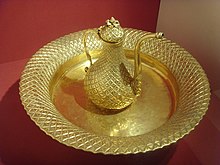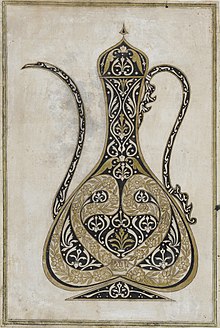
Turkish coffee is a style of coffee prepared in a cezve using very finely ground coffee beans without filtering.
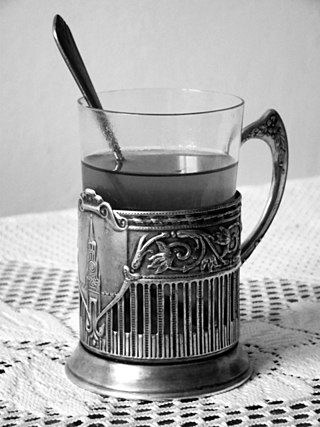
A zarf is a holder, usually of ornamental metal, for a coffee cup without a handle.

Maghrebi mint tea, also known as Moroccan mint tea and Algerian mint tea, is a North African preparation of gunpowder green tea with spearmint leaves and sugar.

Tasseography is a divination or fortune-telling method that interprets patterns in tea leaves, coffee grounds, or wine sediments.

Mokha, also spelled Mocha, or Mukha, is a port city on the Red Sea coast of Yemen. Until Aden and al Hudaydah eclipsed it in the 19th century, Mokha was the principal port for Yemen's capital, Sanaa. Long known for its coffee trade, the city gave its name to Mocha coffee.

A cezve, also ibriki/briki and srjep is a small long-handled pot with a pouring lip designed specifically to make Turkish coffee. It is traditionally made of brass or copper, occasionally also silver or gold. In more recent times cezveler are also made from stainless steel, aluminium, or ceramics.

Arabic coffee is a version of the brewed coffee of Coffea arabica beans. Most Arab countries throughout the Middle East have developed distinct methods for brewing and preparing coffee. Cardamom is an often-added spice, but it can alternatively be served plain or with sugar.
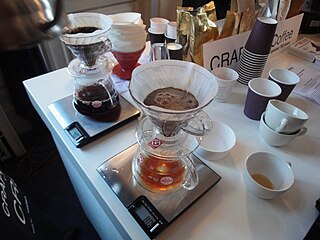
Coffee preparation is the process of turning coffee beans into liquid coffee. While the particular steps vary with the type of coffee and with the raw materials, the process includes four basic steps: raw coffee beans must be roasted, the roasted coffee beans must then be ground, and the ground coffee must then be mixed with hot or cold water for a specific time (brewed), the liquid coffee extraction must be separated from the used grounds, and finally, if desired, the extracted coffee is combined with other elements of the desired beverage, such as sweeteners, dairy products, dairy alternatives, or toppings.

The moka pot is a stove-top or electric coffee maker that brews coffee by passing boiling water pressurized by steam through ground coffee. Named after the Yemeni city of Mocha, it was invented by Italian engineer Luigi Di Ponti in 1933 who sold the patent to Alfonso Bialetti, an aluminum vendor. It quickly became one of the staples of Italian culture. Bialetti continues to produce the original model under the trade name "Moka Express".

Coffee culture is the set of traditions and social behaviors that surround the consumption of coffee, particularly as a social lubricant. The term also refers to the cultural diffusion and adoption of coffee as a widely consumed stimulant. In the late 20th century, espresso became an increasingly dominant drink contributing to coffee culture, particularly in the Western world and other urbanized centers around the globe.

Jebena is a traditional Ethiopian and Eritrean flask made of pottery and used to brew Arabic coffee. It is also widely used in Sudan, and the coffee itself is called bunna.

The cuisine of Bahrain consists of dishes such as biryani, harees, khabeesa, machboos, mahyawa, maglooba, quzi and zalabia. Arabic coffee (qahwah) is the national beverage.
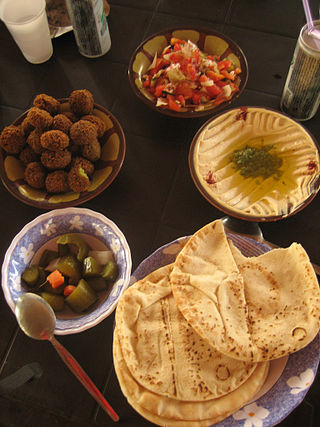
Jordanian cuisine is a Middle Eastern cuisine that has the traditional style of food preparation originating from, or commonly used in, Jordan that has developed through centuries of social and political change.
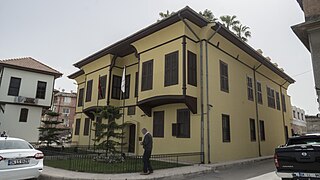
Atatürk Museum exhibits War of Independence and the first years of Republic at the mansion, Atatürk stayed during his trips to Adana. Overlooking to the Seyhan River, the museum is located on Seyhan Street and it is open to public every day except Mondays. Atatürk's visit to Adana is officially celebrated in this building every year on 15 March.

A dallah is a traditional Arabic coffee pot used for centuries to brew and serve Qahwa (gahwa), an Arabic coffee or Gulf coffee made through a multi-step ritual, and Khaleeji, a spicy, bitter coffee traditionally served during feasts like Eid al-Fitr.

A coffeemaker, coffee maker or coffee machine is a cooking appliance used to brew coffee. While there are many different types of coffeemakers, the two most common brewing principles use gravity or pressure to move hot water through coffee grounds. In the most common devices, coffee grounds are placed into a paper or metal filter inside a funnel, which is set over a glass or ceramic coffee pot, a cooking pot in the kettle family. Cold water is poured into a separate chamber, which is then boiled and directed into the funnel and allowed to drip through the grounds under gravity. This is also called automatic drip-brew. Coffee makers that use pressure to force water through the coffee grounds are called espresso makers, and they produce espresso coffee.
Mırra is a traditional type of bitter coffee prepared in the Hatay, Adana, Urfa and Mardin provinces of Turkey, as well as in some Arab countries like Lebanon and Syria, which is also sometimes correctly referred to as Arabic coffee because the name is derived from Arabic; mur meaning bitter. Since it is very bitter and dark, it is served in tiny cups without handles similar in size to Italian espresso cups. The coffee beans for Mırra are common coffea arabica coffee beans that are roasted twice to increase the bitter taste. They are ground so that they are still grainy, unlike Turkish coffee, which is more like a powder. The coffee is put into a narrow-topped small boiling pot called cezve, and water is added, usually accompanied by some cardamom to give a more aromatic flavour.

Arabic tea (Arabic: شاي عربي, romanized: šāy ʿarabiyy, (pronounced shay[ʃæiː], is a variety of hot teas popular throughout the Arab world. It is commonly served to guests and business partners at meetings and social events, and has been drunk by Arab people for centuries.
